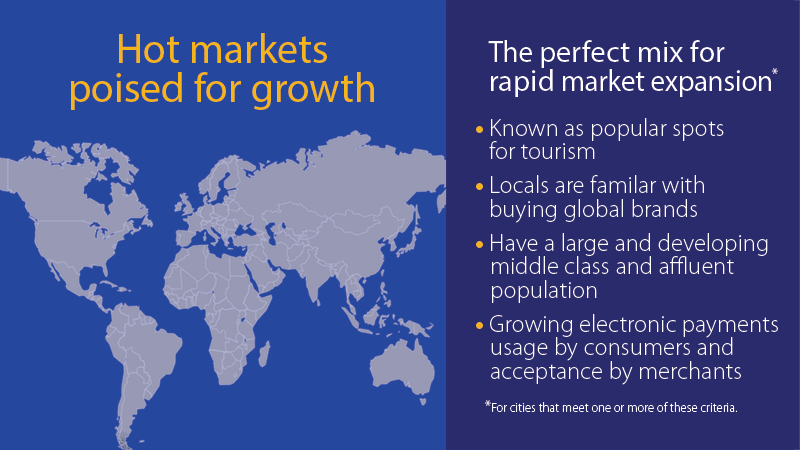6 hot spots poised to fuel the global economy
The global economy could add the equivalent of another U.S. by 2030 with these hot spots revving to take the lead

Global digital platforms and social media have made the world smaller, to the point where consumers from Cairo to Rio follow the same food, fashion and entertainment news and trends at viral speed. This wave of globalization marks a rapid shift in how consumers spend, especially those entering the ranks of the middle class in developing countries. This transformation is the focus of a new study that includes the Visa Globalization Index, a measure globalization levels among cities around the world, including emerging markets. Visa Chief Economist Wayne Best highlights the findings in this video.
Visa and Oxford Economics looked at more than 100 cities and categorized them as non-global, globalizing and global, based on five pillars:
- The size of the city’s middle class
- Its importance to international tourism
- Its trade volume
- Access to digital payments
- Development of global brands
The data shows that businesses in cities that are globalizing today, such as Buenos Aires, Warsaw and Delhi, are well-positioned to expand into markets where they currently have no or limited presence.
The study estimated that the growing middle class in developing and developed countries will add $15 trillion in aggregate to consumer spending by 2030—that’s equal to adding a second United States to global consumption. Rising living standards means more people can shop for amenities like refrigerators, washing machines and cars, make aspirational purchases and seek out global brands (the study found that middle-class shoppers are more likely to spend on global restaurant and apparel brands).
As more people gain middle class status in emerging countries, their spending patterns should gradually resemble those in developed countries. Take, for example, the sharing economy. Few Visa cardholders, outside of the San Francisco Bay Area where most platforms originated, were using ride-sharing and other shared economy apps in 2015. Just two years later the phenomenon had spread to more than 80 cities across the globe.
The study notes that understanding the nuances of consumer behavior can help global brand managers make the most effective payments, supply chain and product lifecycle management decisions as they position themselves in new markets. Put simply, understanding the wide-ranging effects of a more affluent global population could help business and policy leaders ensure economic success and prepare for the future.
Learn more about the findings in the full report and watch the Global Middle Class Consumption video.